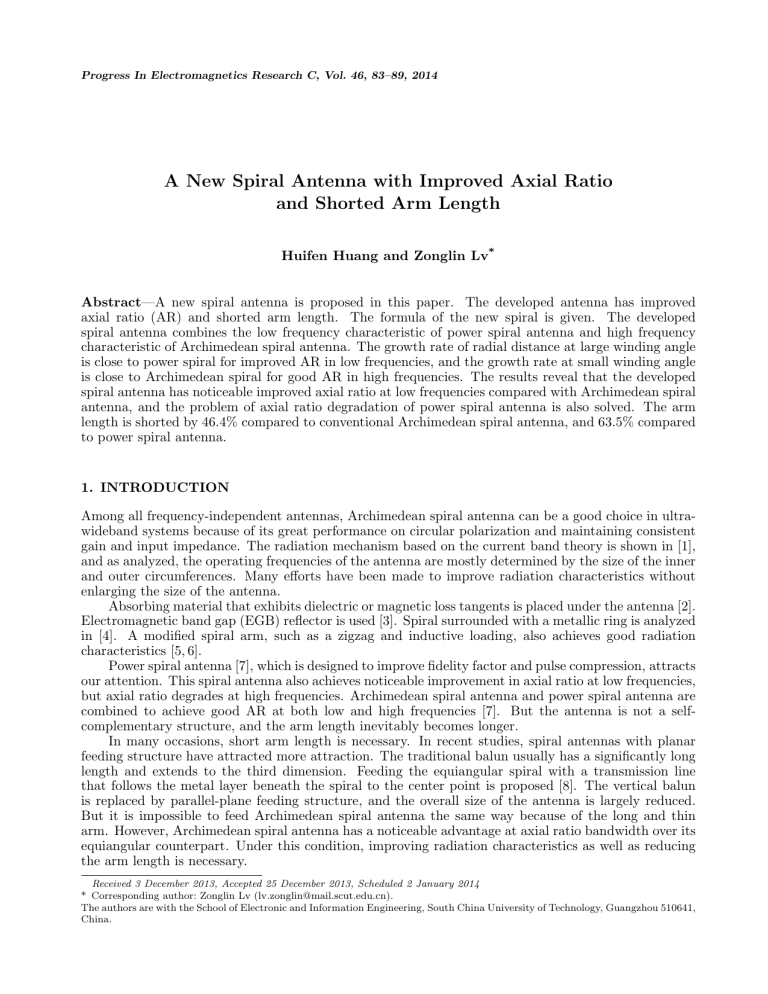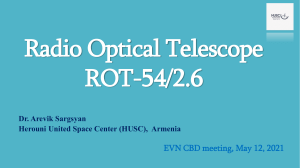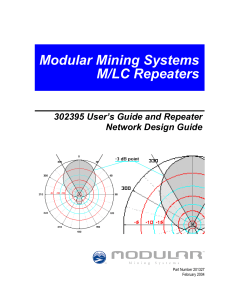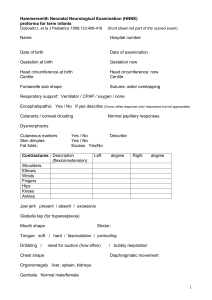
Progress In Electromagnetics Research C, Vol. 46, 83–89, 2014 A New Spiral Antenna with Improved Axial Ratio and Shorted Arm Length Huifen Huang and Zonglin Lv* Abstract—A new spiral antenna is proposed in this paper. The developed antenna has improved axial ratio (AR) and shorted arm length. The formula of the new spiral is given. The developed spiral antenna combines the low frequency characteristic of power spiral antenna and high frequency characteristic of Archimedean spiral antenna. The growth rate of radial distance at large winding angle is close to power spiral for improved AR in low frequencies, and the growth rate at small winding angle is close to Archimedean spiral for good AR in high frequencies. The results reveal that the developed spiral antenna has noticeable improved axial ratio at low frequencies compared with Archimedean spiral antenna, and the problem of axial ratio degradation of power spiral antenna is also solved. The arm length is shorted by 46.4% compared to conventional Archimedean spiral antenna, and 63.5% compared to power spiral antenna. 1. INTRODUCTION Among all frequency-independent antennas, Archimedean spiral antenna can be a good choice in ultrawideband systems because of its great performance on circular polarization and maintaining consistent gain and input impedance. The radiation mechanism based on the current band theory is shown in [1], and as analyzed, the operating frequencies of the antenna are mostly determined by the size of the inner and outer circumferences. Many efforts have been made to improve radiation characteristics without enlarging the size of the antenna. Absorbing material that exhibits dielectric or magnetic loss tangents is placed under the antenna [2]. Electromagnetic band gap (EGB) reflector is used [3]. Spiral surrounded with a metallic ring is analyzed in [4]. A modified spiral arm, such as a zigzag and inductive loading, also achieves good radiation characteristics [5, 6]. Power spiral antenna [7], which is designed to improve fidelity factor and pulse compression, attracts our attention. This spiral antenna also achieves noticeable improvement in axial ratio at low frequencies, but axial ratio degrades at high frequencies. Archimedean spiral antenna and power spiral antenna are combined to achieve good AR at both low and high frequencies [7]. But the antenna is not a selfcomplementary structure, and the arm length inevitably becomes longer. In many occasions, short arm length is necessary. In recent studies, spiral antennas with planar feeding structure have attracted more attraction. The traditional balun usually has a significantly long length and extends to the third dimension. Feeding the equiangular spiral with a transmission line that follows the metal layer beneath the spiral to the center point is proposed [8]. The vertical balun is replaced by parallel-plane feeding structure, and the overall size of the antenna is largely reduced. But it is impossible to feed Archimedean spiral antenna the same way because of the long and thin arm. However, Archimedean spiral antenna has a noticeable advantage at axial ratio bandwidth over its equiangular counterpart. Under this condition, improving radiation characteristics as well as reducing the arm length is necessary. Received 3 December 2013, Accepted 25 December 2013, Scheduled 2 January 2014 * Corresponding author: Zonglin Lv ([email protected]). The authors are with the School of Electronic and Information Engineering, South China University of Technology, Guangzhou 510641, China. 84 Huang and Lv In this paper, a new spiral structure is proposed which achieves improved axial ratio at the same size as typical Archimedean spiral, and the problem of axial ratio degradation of power spiral antenna is also solved. The arm length is largely shorted by 46.4% compared to Archimedean spiral antenna and 63.5% compared to power spiral antenna. With wider arm in the center and largely shorted arm length, the parallel feeding way [8] can be used to remove the vertical balun. More study on feeding the new spiral at parallel plane will follow. The improved axial ratio also means size reduction of spiral structures. Conventional Archimedean spiral antenna, power spiral antenna, and the new spiral antenna will be discussed on radiation characteristics and arm length in this paper. 2. ANTENNA DESIGN Figure 1 shows the geometry of the spiral antennas which will be discussed in this paper. These three antennas are defined by the formulas below: r (ϕ) = r0 + A1 ∗ ϕ (1) r (ϕ) = r0 ∗ [A2 ∗ ϕ + 1]B2 · ¸ arctan (ϕ − B3 ) r (ϕ) = r0 ∗ A3 ∗ + D3 C3 (2) (3) where r is radial distance and ϕ the winding angle. The inner and outer radii are defined by r0 and r1 . The start and end of the winding angle are defined by ϕ0 and ϕ1 . A1 , A2 , A3 , B2 , B3 , C3 , D3 are constants related to the defining geometrical parameters of the antennas. The formulas define the first edge of one arm. The second edge is obtained by rotating the first edge by 90◦ . The second arm is created by rotating the first arm by 180◦ . (a) (c) (b) (d) Figure 1. The antennas discussed in this paper. (a) Archimedean spiral. (b) Power spiral. (c) New spiral. (d) Shorted new spiral. Progress In Electromagnetics Research C, Vol. 46, 2014 85 2.1. Archimedean Spiral In typical Archimedean spiral antenna, coils are equally distributed. As shown in Figure 2, the growth rate of r is a constant. Equation (1) is the defining formula, and the antenna is shown in Figure 1(a). 2.2. Power Spiral As presented in [7], Figure 1(b) shows power spiral antenna, in which coils are not equally distributed. The relationship between r and ϕ is shown in Figure 2. As seen, the growth rate decreases as ϕ increases, which makes the arm wrap tighter as ϕ grows. The defining formula is (2). 2.3. New Spiral Power spiral antenna achieves noticeable improvement in axial ratio at low frequencies, while the axial ratio at high frequencies degrades. Archimedean spiral antenna and power antenna are combined to improve the axial at high frequencies [7], but the arm length inevitably becomes longer. Under this condition, we design an antenna with a similar part at outer coils with power antenna but wrapped tighter in the inner coils. The relationship between r and ϕ is shown in Figure 2. As seen, the growth rate of r is small at the beginning and grows bigger in the middle, and then becomes small again, which makes the antenna tighter at the inner and outer coils and looser in the middle. The new antenna is shown in Figure 1(c). The defining formula is (3). To reduce the arm length, we reduce the winding angle of the antenna, and it is found that the good axial ratio caused by the tight wrapping at the outer circles is not missing as long as we choose the suitable parameters. The end of the winding angle is reduced from 12π to 6.25π. Figure 1(d) shows the shorted spiral antenna. As we fix r0 (ϕ = ϕ0 ) and r1 (ϕ = ϕ1 ), we can easily get ¶ µ ¶ µ ϕ1 − B3 ϕ0 − B3 − r0 ∗ arctan r1 ∗ arctan C3 C3 (4) D3 = r0 − r1 1 µ ¶ A3 = (5) ϕ0 − B3 arctan + D3 C3 So far, if we fix the size of the new spiral, there are only two parameters to tune, B3 and C3 . The final parameters are chosen as B3 = 3, C3 = 3 after numerical simulations aimed to compromise among good axial ratio performance, arm length and fabrication tolerances. Figure 2. The relationship between r and ϕ. 86 Huang and Lv Table 1. Parameters of the antennas. A1 0.475 A2 485.5 B2 0.3 A3 8.27 B3 3 C3 3 D3 0.906 The defining geometrical parameters of the antennas are illustrated in Table 1. All the antennas have the same inner and outer radii r0 = 1 mm and r1 = 19 mm. The arm length can be approximately seen as the length of the first edge. With all these parameters and defining formulas, the arm length of these antennas can be easily calculated by Z ϕ1 L= r(ϕ)dϕ (6) ϕ0 The calculated results of the three antennas are shown in Table 2. The arm length of the new spiral antenna is 201 mm, 46.4% shorter than the conventional Archimedean spiral antenna and 63.5% shorter than power spiral antenna. The largely shorted arm length makes it possible to feed the new spiral antenna from the parallel plane. Table 2. Arm length of the antennas (unit: mm). Archimedean spiral 375 Power spiral 551 Shorted new spiral antenna 201 3. SIMULATION AND MEASUREMENTS These antennas are simulated by the HFSS software. All the antennas are fabricated on the 0.8 mm thick F4B (εr = 2.2) substrate. And all antennas are surrounded with a metallic ring as described in [7]. In the initial simulations, no balun is used. We have assumed matched conditions at the input port, and excitation source impedance is set to 160 Ω in accordance with the simulated input resistance. Figure 3 demonstrates the simulated axial ratio performance for the three antennas. At low frequencies, the axial ratio of new spiral and power spiral has an improvement caused by the relatively tighter wrapping than conventional Archimedean spiral. The tighter wrapping causes increased coupling Figure 3. Simulated axial ratio for the three antennas at front side. Figure 4. Simulated Gain for the three antennas. Progress In Electromagnetics Research C, Vol. 46, 2014 87 between the spiral arms in active region [7]. The increased coupling reduces the residual currents and reflected derivatives. At high frequencies, the axial ratio of power spiral degrades. But the good axial performance of Archimedean spiral is maintained by the new spiral because of the relatively tighter wrapping at the inner coils. While measuring, a wide band tapered transmission line balun is used in impedance matching between the 50 Ω transmission line and the developed antenna. The structure of the balun and antenna is shown in Figure 5. The S11 of the new antenna is measured by Advantest R3770 network analyzer. Figure 6 shows measured and simulated results of S11 of the new spiral antenna, and good reflection coefficient is achieved throughout the desired bandwidth. The discrepancy between the measured and simulated results is due to the difference between computational model and fabricated antenna caused by fabrication and connecting between different parts. The two parts are connected by tin, and the simulated result with the connecting part in the center is also shown. Figure 7 shows the measured and simulated axial ratio performances of the antenna. The measured axial ratio is consistent with the simulated one. The radiation patterns are measured with a microwave absorber. The simulated and measured RHCP gains of the new spiral with balun is shown in Figure 8. And Figure 9 shows the comparison between simulated and measured results of normalized RHCP radiation patterns on the front side at 3 GHz, 6 GHz, and 9 GHz. Discrepancies between measurements and simulations are due to the physical differences between the computational models [7]. (a) (b) Figure 5. Fabricated prototype. (a) Balun and the tested antenna. (b) The fabricated antenna. Figure 6. Measured and simulated S11 . Figure 7. Measured and simulated axial ratio at front side. 88 Huang and Lv Figure 8. Measured and simulated RHCP gain at front side. (a) (b) (c) Figure 9. Measured and simulated radiation pattern. (a) 3 GHz. (b) 6 GHz. (c) 9 GHz. 4. CONCLUSION A new spiral antenna structure is proposed in this paper. The antenna has a similar part at outer circles to power antenna but wraps tighter in the inner circles. The new spiral antenna has noticeable improvement in axial ratio at low frequencies and better performance in high frequencies than power spiral, and the arm length is also largely shorted. ACKNOWLEDGMENT This work is supported by the National Natural Science Foundation of China under Grant 61071056. Progress In Electromagnetics Research C, Vol. 46, 2014 89 REFERENCES 1. Kaiser, J. A., “The Archimedean two-wire spiral antenna,” IRE Trans. Antennas Propag., Vol. 8, No. 5, 312–323, May 1960. 2. Nakano, H., S. Sasaki, H. Oyanagi, and J. Yamauchi, “Cavity-backed archimedean spiral antenna with strip absorber,” IET Proc. Microw. Antennas Propag., Vol. 2, No. 7, 725–730, October 2008. 3. Bell, J. M. and M. F. Iskander, “A low-profile archimedean spiral antenna using an EBG ground plane,” IEEE Antennas Wireless Propagation Letters, Vol. 3, 223–226, 2004. 4. Liu, Q., C. L. Ruan, L. Peng, and W. X. Wu, “A novel compact Archimedean spiral antenna with gap-loading,” Progress In Electromagnetics Research Letters, Vol. 3, 169–177, 2008. 5. Tzanids, I., C. C. Chen, and J. L. Volakis, “Low profile spiral on a thin ferrite ground plane for 220–500 MHz operation,” IEEE Transactions on Antennas and Propagation, Vol. 58, No. 11, 3715–3720, November 2010. 6. Kramer, B. A., C.-C. Chen, and J. L. Volakis, “Sizereduction of a low-profile spiral antenna using inductive and dielectric loading,” IEEE Antennas and Wireless Propagation Letters, Vol. 7, 22–25, 2008. 7. Elmansouri, M. A. and D. S. Filipovic, “Low-dispersion spiral antennas,” IEEE Transactions on Antennas and Propagation, Vol. 60, No. 12, 5522–5530, December 2012. 8. Veysi, M. and M. Kamyab, “Bandwidth enhancement of low-profile PEC-backed equiangular spiral antennas incorporating metallic posts,” IEEE Transactions on Antennas and Propagation, Vol. 59, No. 11, 4315–4318, 2011.








